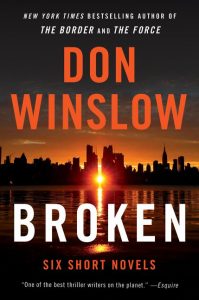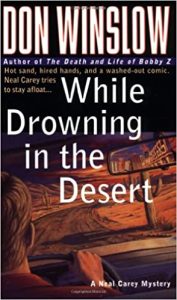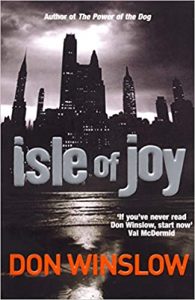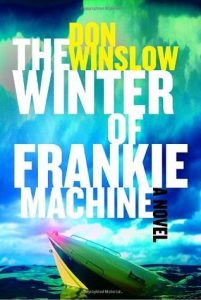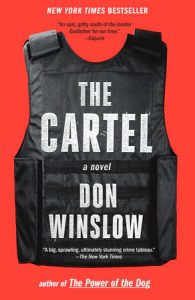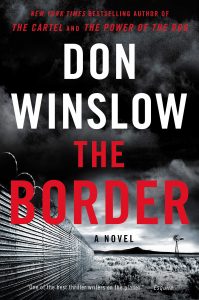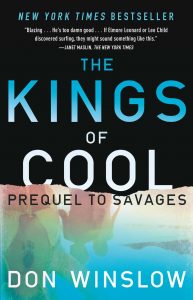Ten years ago, Don Winslow was a San Diego-based novelist with a small, but hardcore following of crime fiction aficionados. Since then, thanks to the breakout success of his epic Cartel Trilogy, Winslow’s popularity has soared among readers with a taste for hard-hitting, socially-engaged thrillers. In the wake of his most recent book, The Border, the trilogy’s final installment, Winslow is riding a new wave of attention, with feature stories in The New York Times, Vanity Fair and Rolling Stone, to name a few. The author of 18 crime novels has also become a powerful advocate for lesser-known crime writers and an increasingly vocal social critic. Today, if you follow crime fiction, then you know the name Winslow and you probably have one of his novels on your nightstand. But have you explored the full depths of his work? If the answer is no, then now is the time to start. This year Winslow is poised to attract even more attention, with FX planning to turn the Cartel Trilogy into a series and Hollywood heavyweights bringing The Force, Winslow’s pull-no-punches crime novel starring a bent NYPD detective, to the screen.
Winslow’s back catalog deserves as wide an audience as the one his current novels are enjoying. His best novels have the swagger of Elmore Leonard and the wit of Carl Hiaasen. Winslow’s work may even be closer to songwriters like Lowell George, Alejandro Esquevedo and even Bob Dylan than to contemporary crime novelists. George, Esquevedo and Dylan tell stories about the sinners and the saints lost and found along the borderlines of America. Winslow does something similar with his crime stories.
It is a longstanding cliché to describe America as a “melting pot.” From 30,000 feet in the air, maybe that is what the country appears to be. But on the ground, where Winslow works his magic, America is a collection of very distinct tribes divided by borders of every kind: both geographical and cultural, both real and imagined.
Winslow’s best novels come alive along those borders. He writes about the walls that separate the United States from Mexico, and the “Orange Curtain” that divides Orange County from the rest of California. He describes the tribal boundaries between surfers and stoners on the Southern California coastline and between the sub-cultures of the California criminal underworld. For my money, no one is better than Winslow at drawing the fine lines that exist between private investigators and cops, between cops and criminals, and between cops who enforce the law and those who choose to break it.
Over the past year, I have been immersed in the Winslow canon and it has been one hell of a ride. Winslow’s action-packed stories allowed me to chopper into drug cartel hot zones with DEA agents like Art Keller, and to ride the heaviest surf with Boone Daniels, Bobby Z, and Frankie Machine. I visited the darkest corners of the Southern California drug trade with Winslow’s “Kings of Cool,” and patrolled the meanest streets of New York with NYPD’s Denny Malone and the Manhattan North Special Task Force. With Winslow as my guide, I crossed into Mexico more times than I can count at more entry points than I knew existed.
Don Winslow gave me a front row seat to all of that action. He gets his characters so close to danger and the experience is so visceral that there were times when I feared for the author. How did Winslow get this material? Just what has this man done and where has he been?
I don’t have the answers to those existential questions. But I do have a list of ten Winslow crime novels that you should read now. Read in sequence, they not only chart the author’s evolving vision of crime in America but also the potential for crime fiction to tell stories that capture the intricate webs of corruption, violence and deceit at the heart of the American Dream.
The Early Books
Winslow started writing after stints as a private investigator in New York and a safari guide in Africa. In 1991, he published the first of five novels featuring eccentric private eye Neal Carey. The Carey novels are out of print, but another early effort, Isle of Joy, is well worth tracking down. Published in 1996 under a pseudonym, Isle of Joy is set in 1958 Manhattan and features private investigator Walter Withers, an ex-CIA operative, digging through Cold War political intrigue. The title is a nod to Richard Rodgers and Lorenz Hart’s love letter to New York City, “I’ll Take Manhattan,” and its promise to turn the borough into an “isle of joy.” Winslow has always been something of a chameleon stylistically and Isle of Joy reads like his homage to James Ellroy’s “Underworld USA” series, complete with allusions to JFK and J. Edgar Hoover.
The Surf Noir Series.
For me, Winslow found his stride with the publication of The Death and Life of Bobby Z. With Bobby Z, Winslow embarked on a series of crime novels best described as “surf noir.” The surf noir stories are terse crime dramas set along the deceptively sunny coastlines of San Diego County. All of the books feature heroes who surf, men who are not afraid to cross boundaries, tribal, legal, or ethical. The Death and Life of Bobby Z, The Winter of Frankie Machine, California Fire and Life, and The Dawn Patrol are my favorite of Winslow’s surf noir books. If you have not read Winslow’s back catalog, then I suggest you start with any of these four. Bobby Z revolves around the story of legendary surfer/drug dealer Bobby Z and a DEA plot to turn the tables on the Mexican drug cartels. Fire and Life treats readers to a ride-along with Orange County arson investigator Jack Wade that includes a rollicking side trip to the steam rooms and gambling clubs of Russian and Armenian mobsters. The Dawn Patrol, like its sequel The Gentleman’s Hour, features a part-time private investigator and full-time surfer named, wait for it, Boone Daniels, a laid-back cross between Phillip Marlowe and Jeffrey “The Dude” Lebowski. Boone’s dude-speak analysis of the tao surfing is a classic slice of Winslow’s surf-noir:
A wave puts you in your exact place in the universe. Say you’re just all full of yourself, you think you’re the king of the world, and you go out, and then this wave just slams you—picks you up, throws you down, rolls you, scrapes you along the bottom, and holds you there a while. Like it’s God saying, ‘Listen, speck, when I let you back up, take a gulp of air, and step away from yourself a little bit.’ Or say you’re really low; you go out and you’re feeling like crap, like there’s not a place for you in the world. You go out there, and the ocean gives you this sweet ride, like it’s all just for you, you know? And that’s God saying, ‘Welcome, son, it’s for you and it’s all good.’ A wave always gives you what you need.
My favorite of the San Diego surf-noir novels is The Winter of Frankie Machine. Frankie Machine tells the cinematic story of Frank Machianno, aka Frankie Machine, the San Diego mob’s top hit-man, an attractive loner whose “special set of skills” are put to the test when he becomes a target. Frankie Machine has long been rumored to be turned into a film, with names like Friedkin, Mann, DeNiro and DiCaprio attached to it at various times over the past fifteen years. Hollywood, if you are listening, Winslow’s fans are begging you to bring Frankie Machine to life on screen.
The Cartel Trilogy
The Border completed the story Winslow began with The Power of the Dog in 2007 and continued with The Cartel in 2015. The three books are certainly the author’s most well-known. However, success did not come right away. Winslow broke slowly in the United States. The Power of the Dog was a book that most American readers missed. Acting on a tip from British filmmaker Olly Blackburn, an early champion of Winslow, I picked up a paperback of The Power of the Dog while touring London in 2008. Over the next 12 years, I worked my way through all three volumes and 2000 plus pages of the Cartel Trilogy.
What I discovered is that few books, fact or fiction, chronicle America’s “war on drugs” better than Winslow’s trilogy—a harrowing journey through the heart of darkness Winslow sees when he looks that “war.” Scenes that seem too gruesome to believe on the page are proven true in the headlines.
In Winslow’s view there are no winners in this war. The author’s point of view is summed up by his protagonist throughout the series, DEA agent Art Keller:
We’ll never find an answer to the drug problem until we ask the big questions about systemic corruption; the nexus between drug trafficking, government, and business; the prison-industrial complex that is funded by drug convictions; and the very nature of drug use and addiction itself. What is the true nature of the drug-trafficking machine? What is the depth and width of the corruption that allows it to flourish? Where do the billions of dollars go? How does it provide protection, and who provides that protection?
And something else.
What is the corruption of the American soul that makes us want the drugs in the first place? Opioids—which are killing more Americans now than either car crashes or guns—are a response to pain. We have to ask the question: what is the pain?
Until we ask and answer that question, the drug problem will always be with us.
Behind the Orange Curtain
If Cartel Trilogy is among the very best fiction about the border wars, then Savages and its prequel The Kings of Cool are two of the best books about the impact of those wars in America. In both books, Winslow experiments with a staccato prose style that mimics the laconic half-sentences and tribal slang of Orange County’s cool kids. He also employs cinematic tricks such as screenplay excerpts and tracking shots. For me, the experiments work, and make the books compulsively readable. These are books a reader could devour on a long plane ride, or during a long weekend getaway.
As a bonus, watch Oliver Stone’s movie version of Savages, written by Stone, Winslow and Shane Salerno. British critics hailed it as a Southern California masterwork, but American critics and audiences ignored it. Decide for yourself. I promise you this, thanks to the talents of Stone, Winslow and Salerno, the film looks great, the dialog sparkles and there is never a dull moment.
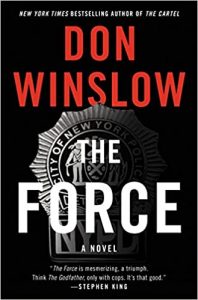
The Mean Streets of New York.
Let’s end our tour where we started—back in Manhattan—with Winslow’s 2017 novel, The Force. This time around, the setting is the present and there is little joy on the island. I put off reading The Force, mistakenly buttonholing Winslow as a “Western” writer. But Winslow has roots in the East, and he did his homework to bring the city streets to life. The story follows an elite team of NYPD cops who are not afraid to straddle, and sometimes erase, the vital borderline between enforcing the law and breaking the law. Detective Denny Malone, the team’s leader, is surrounded by enemies, both inside and outside the NYPD, and even at home. But, on the street, he is free, a Prince of the City. For Malone, “The street is always good. It where Malone feels at home, in charge, in control of himself and his environment. No matter what the problem is, the answer is always in the street.” The Force is an uncompromising portrait of those streets. It is also one of Winslow’s finest. Don’t miss it.
* * *
There it is: ten crime novels you should read now. I suggest that start soon. Because I know that right now, somewhere in the dark corners of America that most of us will never visit, Don Winslow is working. Somewhere along the borderline between the dark and the light, where everything looks gray, Winslow is carving a path for his readers to follow. As the author observes in Bobby Z, “Bad things happen on the border at night.” I know that when those bad things do happen, Winslow will be there to write about them. I look forward to the next chapter.
—Winslow’s Broken, a collection of six short novels, will be released this month.


